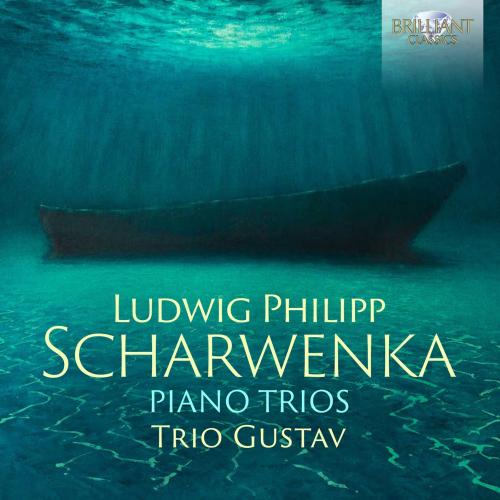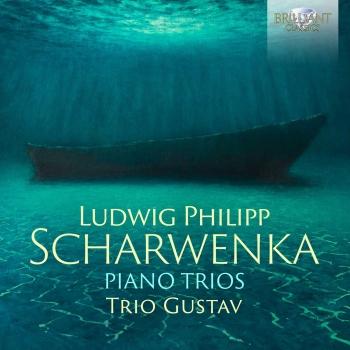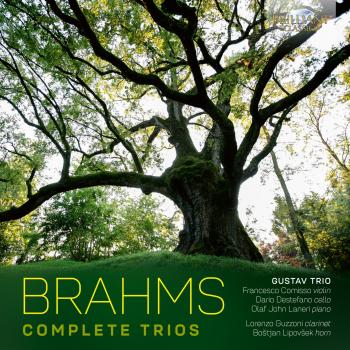
Scharwenka: Piano Trios Trio Gustav
Album Info
Album Veröffentlichung:
2022
HRA-Veröffentlichung:
27.05.2022
Label: Brilliant Classics
Genre: Classical
Subgenre: Chamber Music
Interpret: Trio Gustav
Komponist: Philipp Scharwenka (1847-1917)
Das Album enthält Albumcover
- Ludwig Philipp Scharwenka (1847 - 1917): Piano Trio No. 1 in C-Sharp Minor, Op. 100:
- 1 Scharwenka: Piano Trio No. 1 in C-Sharp Minor, Op. 100: I. Largo e tranquillo 07:28
- 2 Scharwenka: Piano Trio No. 1 in C-Sharp Minor, Op. 100: II. Allegro 05:25
- 3 Scharwenka: Piano Trio No. 1 in C-Sharp Minor, Op. 100: III. Allegro appassionato 08:17
- Piano Trio No. 2 in G Major, Op. 112:
- 4 Scharwenka: Piano Trio No. 2 in G Major, Op. 112: I. Allegro moderato 08:34
- 5 Scharwenka: Piano Trio No. 2 in G Major, Op. 112: II. Andante tranquillo 07:51
- 6 Scharwenka: Piano Trio No. 2 in G Major, Op. 112: III. Allegro con spirito 07:17
Info zu Scharwenka: Piano Trios
Around a quarter of a century ago, scholars embarked upon fruitful research into composers active between the mid-19th century and the lead-up to World War One, many largely hitherto ignored by all but music historians, consisting of at least two generations who focused either on ‘absolute’ music (in central Europe) or music for the theatre (in Italy and France). Philipp Scharwenka (1847–1917) was one such figure.
Born to a family with ancient Bohemian roots but determinedly German in its culture, Philipp and his concert pianist brother Xaver attended Berlin’s Neue Akademie der Tonkunst, where Philipp would eventually also teach theory. He began composing in earnest in 1874 and the following year founded his own school with his brother, where he would teach composition for the rest of his life.
Philipp Scharwenka’s chamber works, which date mostly from the turn of the century, are some of his most notable compositions and include three piano trios (the first two, recorded here, with violin and cello; the third with violin and viola).
The Trio Op.100 in C sharp minor, published by Breitkopf in 1897, unfolds in flowing, measured writing across three movements with a clearly defined formal range. The composition feels like a well-oiled machine, including all the expressive techniques developed over the years in expertly dosed quantities, and sometimes achieving intense – and never long-winded – lyricism.
The subsequent Trio in G Op.112, published in 1902, again by Breitkopf, is also in three movements. The work’s tonal regions, while very clear and based on sonata form in both the first and third movements, deviate slightly from the traditional relationships by including the relative minor keys too. This is nothing out of the ordinary: it is simply a way to keep the form compact and flowing while testing out slightly more unusual tonality.
Ludwig Philipp Scharwenka (1847-1917) was born in eastern Prussia (now part of Poland) in the town of Samter to a family with ancient Bohemian roots, but determinedly German in its culture. He and his brother Xaver (1850–1924) received their first music lessons from their mother and from the cantor at the local protestant church. In 1865, once they had finished high school, his family moved to Berlin, where the two young men were admitted to the Neue Akademie der Tonkunst, founded by the renowned pianist (and one-time pupil of Carl
Czerny) Theodor Kullak. Philipp was given a job teaching theory at the academy, and in 1874 he began composing in earnest. The following year he founded his own school with his brother, where he would teach composition for the rest of his life. Xaver, who became a famous soloist, later created a branch of their conservatoire in New York, and gave his brother a teaching role there (1891–2). Philipp returned to Berlin and in 1901 became a member of the Prussian Academy of Arts.
Scharwenka’s Piano Trios are firmly rooted in the German Romantic language of Brahms and his contemporaries, a tight harmonic basis provides sweeping romantic melodies and by times a touching lyricism.
The Trio Gustav devote themselves both to the great chamber literature for trio and to the hidden treasures of the Italian chamber repertoire. Their instrumental virtuosity, together with the international concert experience of the three interpreters, merge together so as to charge every performance with energy and elegance.
Trio Gustav
The Trio Gustav
was born from the desire of cellist Dario Destefano and violinist Francesco Comisso to continue their long-standing artistic partnership, already expressed in a previous piano trio, with the collaboration of internationally renowned pianist Olaf John Laneri.
In this formation, the three performers recognise a common ground in which the dialogue between the parts springs from the cult of sound and respect for form, thus devoting themselves both to the great chamber music literature composed for this formation and to the revaluation of that hidden treasure that is the Italian chamber music repertoire.
In addition to compositions by the great composers (Beethoven, Brahms, Schumann, Dvořák, Mendelssohn, Ravel and Šostakovič), the Trio Gustav casually combines works by composers such as Bossi, Busoni, Casella, Martucci and Wolf- Ferrari, with the aim of emancipating their own artistic Italian-ness in a repertoire that is far removed from the more common operatic tradition. The typically Italian instrumental virtuosity and the international concert experience of the three performers come together in a strong and sincere bond in the desire to make each performance charged with energy and interpretative elegance.
Dieses Album enthält kein Booklet












